6/16/19 – 6/29/19
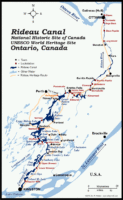 OK, OK, we’re a little behind, as you can see by the dates above. But…we were in Canada, and there was too much fun to be had! We’re now trying to catch up as we make our way back down the East Coast toward the Chesapeake and, ultimately, Florida.
OK, OK, we’re a little behind, as you can see by the dates above. But…we were in Canada, and there was too much fun to be had! We’re now trying to catch up as we make our way back down the East Coast toward the Chesapeake and, ultimately, Florida.
—-
After 3 days of rain, we finally departed Kingston to begin the Rideau Canal. The 126-mile Rideau Canal (pronounced “Reed-O”) is actually made up of natural lakes, rivers, and manmade canals, along with 49 locks. During the War of 1812, the British were concerned about a secure route for their military forces and supplies from Lake Ontario to Quebec, as the US bordered Canada along the St. Lawrence River. They built the canal to provide an alternate route between Montreal, Ottawa and Kingston. (There were never any military engagements.) It opened in 1832 and is a UNESCO World Heritage Site primarily used for pleasure boating today.
 There were 14 locks to raise us 165’ (from 243’ above sea level in Kingston to 408’ above sea level at Upper Rideau Lake). Then 32 locks would lower us 274’ to Ottawa on the Ottawa River at 134’ above sea level. Some of those locks were single locks while others were “flight locks.” Those had chambers end to end with a lock door in between; most were a flight of 2 or 3, but there was one flight in Ottawa that was 8 locks (chambers) long. In a flight lock, we drove into the first chamber, which then raised (or lowered) us to the level of water in the next chamber. We drove out of the first chamber directly into the next chamber, where we again looped a line around a cable on the wall and were raised (or lowered) to the next chamber or level of the water where we would drive out. Click here for how locks work and watch this video of a lockmaster in the Rideau Canal. Locking was slow; transiting a lock required allowing 30 minutes (though it didn’t usually take quite that long). Lowering was easier than rising, as it was very gentle. When the lock was a lift lock, water rushed in (the swiftness depending on the kindness of the lockmaster), which caused the boat to shift around in the swirling water. The locks in the Rideau were almost all mechanical locks, moved by turning a wheel to open or close lock doors or sluices through which water came. The lockmasters really got their exercise as they walked in circles pushing a bar to move a gate or cranked chain with their arms to open a sluice.
There were 14 locks to raise us 165’ (from 243’ above sea level in Kingston to 408’ above sea level at Upper Rideau Lake). Then 32 locks would lower us 274’ to Ottawa on the Ottawa River at 134’ above sea level. Some of those locks were single locks while others were “flight locks.” Those had chambers end to end with a lock door in between; most were a flight of 2 or 3, but there was one flight in Ottawa that was 8 locks (chambers) long. In a flight lock, we drove into the first chamber, which then raised (or lowered) us to the level of water in the next chamber. We drove out of the first chamber directly into the next chamber, where we again looped a line around a cable on the wall and were raised (or lowered) to the next chamber or level of the water where we would drive out. Click here for how locks work and watch this video of a lockmaster in the Rideau Canal. Locking was slow; transiting a lock required allowing 30 minutes (though it didn’t usually take quite that long). Lowering was easier than rising, as it was very gentle. When the lock was a lift lock, water rushed in (the swiftness depending on the kindness of the lockmaster), which caused the boat to shift around in the swirling water. The locks in the Rideau were almost all mechanical locks, moved by turning a wheel to open or close lock doors or sluices through which water came. The lockmasters really got their exercise as they walked in circles pushing a bar to move a gate or cranked chain with their arms to open a sluice.
Here’s how we did locks. Paula drove into the lock, Tom grabbed a forward cable, ran a line around it and cleated it, and then went to the stern to do the same. Then Paula shut down the engine (required in Canada, unlike US locks), came down from the flybridge to the main deck to take one of the lines and minded it while Tom managed the other line during the locking. Then Paula would return to the flybridge, start up the engines, Tom would loose the lines, act as a thruster to push the bow off the wall (we didn’t have any thrusters as some boats do) and out we went.
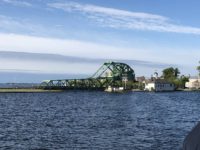 We left the Kingston marina with 2 other boats (Summertime and New Freedom) and headed up the Rideau to make the 8:00 opening of the LaSalle Causeway Bridge and get to the first lock after their 9:00 opening. Summertime was owned by Wally and Darcy Campbell, who we had met on our first Great Loop 3 years prior and were docked 2 slips away from us in Kingston! (It was so good to reacquaint with them!) Upon arriving at our first lock, Lock #49, Kingston Mills (lock numbers counted down to Ottawa), there was another boat, Katy Corrine II, waiting on the “blue line,” a painted line on a dock or wall prior to the lock entrance. Because most of the Rideau lockmasters did not monitor a radio, tying on the blue line indicated a desire to lock through. So, we went through our first 4 locks on the Rideau with 4 boats in the chamber together. It was quite tight. After one boat stopped for the night, we figured out it was best if we (being the biggest) went in first and took one wall while the other 2 boats followed behind and tied to the opposite wall.
We left the Kingston marina with 2 other boats (Summertime and New Freedom) and headed up the Rideau to make the 8:00 opening of the LaSalle Causeway Bridge and get to the first lock after their 9:00 opening. Summertime was owned by Wally and Darcy Campbell, who we had met on our first Great Loop 3 years prior and were docked 2 slips away from us in Kingston! (It was so good to reacquaint with them!) Upon arriving at our first lock, Lock #49, Kingston Mills (lock numbers counted down to Ottawa), there was another boat, Katy Corrine II, waiting on the “blue line,” a painted line on a dock or wall prior to the lock entrance. Because most of the Rideau lockmasters did not monitor a radio, tying on the blue line indicated a desire to lock through. So, we went through our first 4 locks on the Rideau with 4 boats in the chamber together. It was quite tight. After one boat stopped for the night, we figured out it was best if we (being the biggest) went in first and took one wall while the other 2 boats followed behind and tied to the opposite wall.
The first locks, Locks #49-47 were the Kingston Mills Locks, a flight of 3. At the first lock, we bought a season pass for both locks and mooring (lock wall or dock). We planned to be in Canada from June through August, so it was the best deal for us.
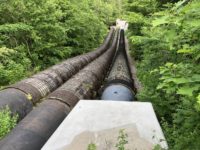 We continued through locks #46-39, most singles (one double, one triple). It was a long tiring day – almost 10 hours and 11 locks. We tied for the night at the floating dock at the top of Jones Falls Lock and all took a short hike to the old lockmaster’s house (one of 12 remaining defensible stone lockmaster’s houses, built-in 1841), the visitor’s center (one small room), and then to the amazing arched dam! The keystone arch dam, constructed of interlocking vertical stones carted from 6 miles away, was one of the first of this type in the world and at the time it was built (the late 1820s), the largest. It was 56’ tall by 350’ across the gorge. And we couldn’t see a single leak! A power station using water through 3 wooden pipes, each about 10’ in diameter, was below the dam.
We continued through locks #46-39, most singles (one double, one triple). It was a long tiring day – almost 10 hours and 11 locks. We tied for the night at the floating dock at the top of Jones Falls Lock and all took a short hike to the old lockmaster’s house (one of 12 remaining defensible stone lockmaster’s houses, built-in 1841), the visitor’s center (one small room), and then to the amazing arched dam! The keystone arch dam, constructed of interlocking vertical stones carted from 6 miles away, was one of the first of this type in the world and at the time it was built (the late 1820s), the largest. It was 56’ tall by 350’ across the gorge. And we couldn’t see a single leak! A power station using water through 3 wooden pipes, each about 10’ in diameter, was below the dam.
There was no need to leave early the next morning. The lockmasters were still on winter hours and did not open the locks until 10:00 on weekdays for another week (10:00 – 4:00 until June 24).
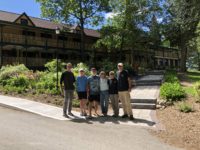 We were in Lock #37, Chaffey’s, when someone mentioned ice cream at Opinicon…so, of course, all 3 of us stopped! It was a beautiful place, well-manicured with lovely grounds and 16 cottages. It became our lunch stop too when we purchased 2 pizza squares with pesto, basil, tomato, and goat cheese. It was exceptional! Then it was back on the boat for another lock before arriving at Big Rideau Lake, the highest point in the Rideau Canal. After transiting Lock #36, Newboro Lock, the colored buoy markers changed places. To remind boaters of the change, leaving the lock were 2 flower pots, the right one painted green, the left one painted red. Such a cute idea!
We were in Lock #37, Chaffey’s, when someone mentioned ice cream at Opinicon…so, of course, all 3 of us stopped! It was a beautiful place, well-manicured with lovely grounds and 16 cottages. It became our lunch stop too when we purchased 2 pizza squares with pesto, basil, tomato, and goat cheese. It was exceptional! Then it was back on the boat for another lock before arriving at Big Rideau Lake, the highest point in the Rideau Canal. After transiting Lock #36, Newboro Lock, the colored buoy markers changed places. To remind boaters of the change, leaving the lock were 2 flower pots, the right one painted green, the left one painted red. Such a cute idea!
 At that lock, we also met lockmaster Ryan. Paula asked how long he had been working the Rideau Locks. He said 7 years. That was a long time (though we’ve met 15-year lockmasters on the Erie Canal). He said it was in his family’s blood; he was a 4th generation lockmaster. His grandfather had lived in the lockmaster’s house we saw at the Kingston Mills Locks!
At that lock, we also met lockmaster Ryan. Paula asked how long he had been working the Rideau Locks. He said 7 years. That was a long time (though we’ve met 15-year lockmasters on the Erie Canal). He said it was in his family’s blood; he was a 4th generation lockmaster. His grandfather had lived in the lockmaster’s house we saw at the Kingston Mills Locks!

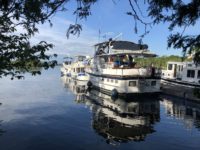 The last lock of the day, Lock #35, Newboro, was our first lock downward. So much easier! We continued across the lake to a floating dock at Colonel By Island. Colonel By, 1779 – 1876, was an English military engineer who was fundamental to the building of the Rideau Canal and many things in the area were named after him. We arrived at the dock with 3 other boats already there. It was quite tight, but we managed to get the 3 of us on the dock with help from the welcoming boaters, all from Clayton, NY. “Docktails” (boater talk for a party on the dock) ensued at 5:30. We really enjoyed getting to know Bob and Barb Honcharski, Gary and Connie Schopfer, and Phil and Kate Pennington.
The last lock of the day, Lock #35, Newboro, was our first lock downward. So much easier! We continued across the lake to a floating dock at Colonel By Island. Colonel By, 1779 – 1876, was an English military engineer who was fundamental to the building of the Rideau Canal and many things in the area were named after him. We arrived at the dock with 3 other boats already there. It was quite tight, but we managed to get the 3 of us on the dock with help from the welcoming boaters, all from Clayton, NY. “Docktails” (boater talk for a party on the dock) ensued at 5:30. We really enjoyed getting to know Bob and Barb Honcharski, Gary and Connie Schopfer, and Phil and Kate Pennington.
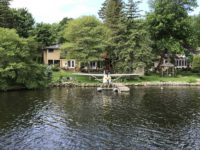
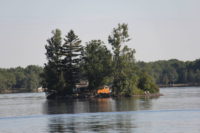 In the morning, we left our new friends and pulled out with Summertime and New Freedom to cruise 2.5 hours before arriving at our first lock, lock #32, Poonamalie, at 10:00. There were many houses along the lake, including one on almost every island, and even a floatplane doing takeoffs and landings. When we got to the lock, there waiting was Katy Corrine II, the boat with which we locked through on Day 1. At the next lock, Smith Falls Lock #31, there was a houseboat waiting, so we let our 3 friends go through with that boat and stayed behind. They were wanting to go long that day but we had plans to meet friends short of Ottawa on Friday and needed to slow down. We stopped for the night at Smith Falls, the third-largest town on the Rideau (first Ottawa, the capital of Ontario; next Kingston).
In the morning, we left our new friends and pulled out with Summertime and New Freedom to cruise 2.5 hours before arriving at our first lock, lock #32, Poonamalie, at 10:00. There were many houses along the lake, including one on almost every island, and even a floatplane doing takeoffs and landings. When we got to the lock, there waiting was Katy Corrine II, the boat with which we locked through on Day 1. At the next lock, Smith Falls Lock #31, there was a houseboat waiting, so we let our 3 friends go through with that boat and stayed behind. They were wanting to go long that day but we had plans to meet friends short of Ottawa on Friday and needed to slow down. We stopped for the night at Smith Falls, the third-largest town on the Rideau (first Ottawa, the capital of Ontario; next Kingston).
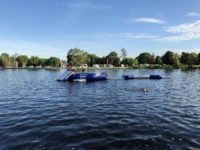 Originally, there were 4 locks at Smith Falls; 3 of the locks were combined into Lock 29A. Before going through the first lock, we walked to Walmart, Canadian Tire, a dollar store, and had lunch at Dairy Queen. (Those Blizzards are like a magnet to us.) Then we locked through the first lock to stay just above Smith Falls Lock 29A. It was the loveliest dockage we had come to on the Rideau Canal. Just off our aft deck was a beautiful large park and a turning basin (an extrusion from the canal originally designed for cargo boats to off-load cargo) with a trampoline on floats with many kids jumping, swimming, laughing, and having fun. And it was the first dock at which we had power, which turned out to be a good thing because it was the first day we wanted air conditioning (power cost $9.90, Canadian, only $7.45 US). Without power, we would have had to run the generator to operate the air conditioner.
Originally, there were 4 locks at Smith Falls; 3 of the locks were combined into Lock 29A. Before going through the first lock, we walked to Walmart, Canadian Tire, a dollar store, and had lunch at Dairy Queen. (Those Blizzards are like a magnet to us.) Then we locked through the first lock to stay just above Smith Falls Lock 29A. It was the loveliest dockage we had come to on the Rideau Canal. Just off our aft deck was a beautiful large park and a turning basin (an extrusion from the canal originally designed for cargo boats to off-load cargo) with a trampoline on floats with many kids jumping, swimming, laughing, and having fun. And it was the first dock at which we had power, which turned out to be a good thing because it was the first day we wanted air conditioning (power cost $9.90, Canadian, only $7.45 US). Without power, we would have had to run the generator to operate the air conditioner.
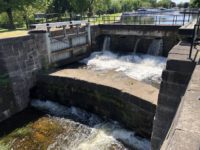 Time to sightsee! After paying, we walked to the detached lock, one of the locks replaced by Lock #29A. Though there was some water in it, it was very low and we could see how the water was diverted and came out the side of the lock wall end, and the sluices in the lock doors (louvers sort of like Venetian blinds the lockmasters opened in varying amounts to let water come into or out of a lock).
Time to sightsee! After paying, we walked to the detached lock, one of the locks replaced by Lock #29A. Though there was some water in it, it was very low and we could see how the water was diverted and came out the side of the lock wall end, and the sluices in the lock doors (louvers sort of like Venetian blinds the lockmasters opened in varying amounts to let water come into or out of a lock).
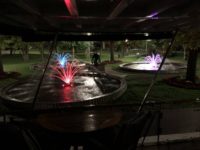 We walked to the Rideau Canal Museum and Visitor’s Center, 5 floors tall, with the history of the Rideau Canal, highlighting Colonel By and the men who helped build the canal. Approximately 1,000 men died during its construction – about 50% from construction accidents and the other 50% from malaria. Though we enjoyed the museum, it seemed unfinished with so much potential if only the city would put some money into tourism. We strolled through downtown, about 10 blocks by 3 blocks, before returning to dinner on our aft deck watching the town members walk the path beside the boat and the kids swim in the basin. We had walked 6.1 miles, the most of any town on the Rideau Canal so far. Paula cut Tom’s hair on a park bench before dark. After dark, the fountains next to the boat had rotating colored spotlights, the best show we had on the Rideau from our aft deck.
We walked to the Rideau Canal Museum and Visitor’s Center, 5 floors tall, with the history of the Rideau Canal, highlighting Colonel By and the men who helped build the canal. Approximately 1,000 men died during its construction – about 50% from construction accidents and the other 50% from malaria. Though we enjoyed the museum, it seemed unfinished with so much potential if only the city would put some money into tourism. We strolled through downtown, about 10 blocks by 3 blocks, before returning to dinner on our aft deck watching the town members walk the path beside the boat and the kids swim in the basin. We had walked 6.1 miles, the most of any town on the Rideau Canal so far. Paula cut Tom’s hair on a park bench before dark. After dark, the fountains next to the boat had rotating colored spotlights, the best show we had on the Rideau from our aft deck.
Prior to Paula’s getting sick and us being off the boat for  almost 21 months, we had painted the toerail on the front half of the boat. The aft half remained with peeling varnish, awaiting further time for repair. It was so difficult to get boat chores done while we were traveling and sightseeing. It had to be done in bits and pieces. In the morning, we scraped and sanded on the aft toerail before we departed.
almost 21 months, we had painted the toerail on the front half of the boat. The aft half remained with peeling varnish, awaiting further time for repair. It was so difficult to get boat chores done while we were traveling and sightseeing. It had to be done in bits and pieces. In the morning, we scraped and sanded on the aft toerail before we departed.
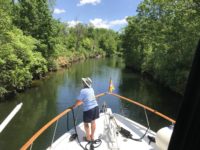 The journey from Smith Falls to Merrickville, only 14 miles, was so pleasant. For the first day, we locked all alone. We began through Smith Falls 29A. All 4 locks of the day were easy, but we saw the shallowest depth we had seen – 5.8 feet. Our boat draws 4.5’, so anything less than 7’ gets our attention. We were right where we should have been, but we had been warned there were areas shallower than the 7’ to which the canal was supposed to be dredged.
The journey from Smith Falls to Merrickville, only 14 miles, was so pleasant. For the first day, we locked all alone. We began through Smith Falls 29A. All 4 locks of the day were easy, but we saw the shallowest depth we had seen – 5.8 feet. Our boat draws 4.5’, so anything less than 7’ gets our attention. We were right where we should have been, but we had been warned there were areas shallower than the 7’ to which the canal was supposed to be dredged.
Our plan was to dock on a floating dock in “The Pond” above the Merrickville Lock (an area separate from the canal, above the dam). Just before we arrived, 2 other boats docked on each side of the approach end of the dock. They were just finishing tying up their boats when we approached and we hoped they would offer to pull forward to make room for us to dock more easily…but they didn’t. Instead, we had to pass them and basically parallel park in an area little larger than our boat, with some wind blowing. Paula didn’t know it, but at one point, Tom heard one of the women exclaim, “She’s going to hit our boat!” (We weren’t even close.) The sunset that evening was beautiful!.
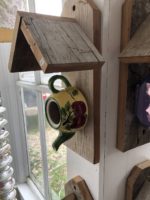
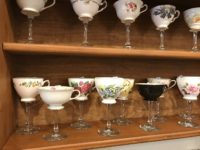 After paying for our power at the lockmaster’s office, we strolled through the outdoor market, then walked main street. It was a small but pretty town with several limestone buildings and pretty churches and lots of shops. We enjoyed the kitchen store and Paula really enjoyed My Vintage Revamped, an up-cycled shop. Tammy Best, the super-creative owner upcycled jewelry, accessories, and clothing into new things. She made men’s ties into ladies’ cowls, used broken china pieces in bracelets and necklaces, and put china teacups on stems as pretty wine glasses. She said very few young people today wanted Mom’s or Grandma’s china, but upcycling it made it into a precious and usable heirloom.
After paying for our power at the lockmaster’s office, we strolled through the outdoor market, then walked main street. It was a small but pretty town with several limestone buildings and pretty churches and lots of shops. We enjoyed the kitchen store and Paula really enjoyed My Vintage Revamped, an up-cycled shop. Tammy Best, the super-creative owner upcycled jewelry, accessories, and clothing into new things. She made men’s ties into ladies’ cowls, used broken china pieces in bracelets and necklaces, and put china teacups on stems as pretty wine glasses. She said very few young people today wanted Mom’s or Grandma’s china, but upcycling it made it into a precious and usable heirloom.
 We walked to the original lock ruins, which had many of the original structures (grain mill, hydro plant, other buildings). Back at the boat, Paula heard kids jumping into and swimming in the pool below the lock. There were no fences protecting the water’s edge, although there were signs saying swimming was prohibited. Mom said every afternoon during the summer (after the lockmasters went home, of course), the locals swam. In the US, that would be called an “attractive nuisance” and lawsuits would soon have the area protected with barricades.
We walked to the original lock ruins, which had many of the original structures (grain mill, hydro plant, other buildings). Back at the boat, Paula heard kids jumping into and swimming in the pool below the lock. There were no fences protecting the water’s edge, although there were signs saying swimming was prohibited. Mom said every afternoon during the summer (after the lockmasters went home, of course), the locals swam. In the US, that would be called an “attractive nuisance” and lawsuits would soon have the area protected with barricades.
The forecasted rain started just before 10:00 AM the next morning, the lock-opening time. The raindrops on our O’Sea glass (the translucent plastic-like windows on our flybridge) made visibility more difficult. Though we only did 6 miles, we locked through all 7 locks in the rain, alone…the way we like it. Alone, there was no wasted time waiting for other boats to drive in, get in position, and drive out. And no chance of contact with anyone else.
Once through Burritts Rapid, we docked on the floating dock on the other side of the land adjacent to the dock. There was one other boat there, and in spite of a depth of 3’ on the chart, the lockmasters said there was about 10’. Potato soup warmed us up from the damp of the day.
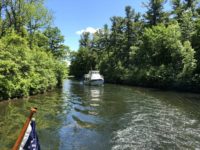
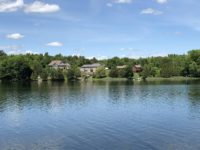 Friday morning, day 6, we entered what was to become our favorite stretch of the Rideau Canal. It was the longest lock-free section (25.5 miles) appropriately named, the “Long Reach.” It was a very tranquil ride through pine forests, wetlands, working farms and estate homes on water composed of several large lakes, then closer to Ottawa, more canal. Houses with boats and/or kayaks and canoes lined with water. We loved looking at the houses, most reasonably-sized. We stopped just above Lock 16 and were the only boat there. It was a very peaceful and quiet night.
Friday morning, day 6, we entered what was to become our favorite stretch of the Rideau Canal. It was the longest lock-free section (25.5 miles) appropriately named, the “Long Reach.” It was a very tranquil ride through pine forests, wetlands, working farms and estate homes on water composed of several large lakes, then closer to Ottawa, more canal. Houses with boats and/or kayaks and canoes lined with water. We loved looking at the houses, most reasonably-sized. We stopped just above Lock 16 and were the only boat there. It was a very peaceful and quiet night.
The reason we had slowed our pace was to meet friends for the weekend. We had met Paul and Cecelia on a Panama Canal cruise we had taken the previous November and they told us to call them when we got on the Rideau Canal as they were within an hour of almost anywhere on the canal. We invited them to join us for a few days, so to allow them some travel time on the boat, we drug our feet through the week to stop a day short of Ottawa on Friday.

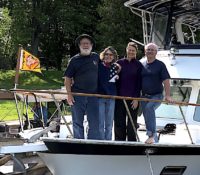 Paul and Cecelia arrived about 4:30 and we reconnected with them on the aft deck. It is always so wonderful when after time apart, relationships continued just as if there were no time lapse. Paul had made a reservation at Black Dog restaurant in Manotick (our previous lock) and refused any argument. The seared snapper and beet salad were terrific! But the lemon curd-topped cheesecake…well, that took the cake. For citrus lovers, it was to die for. We walked town and visited Watson’s Mill, built in 1860, before returning to the boat.
Paul and Cecelia arrived about 4:30 and we reconnected with them on the aft deck. It is always so wonderful when after time apart, relationships continued just as if there were no time lapse. Paul had made a reservation at Black Dog restaurant in Manotick (our previous lock) and refused any argument. The seared snapper and beet salad were terrific! But the lemon curd-topped cheesecake…well, that took the cake. For citrus lovers, it was to die for. We walked town and visited Watson’s Mill, built in 1860, before returning to the boat.
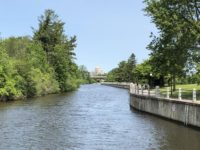
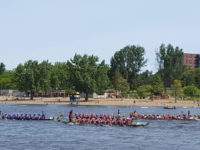 Paul proved to be a handy deckhand and a great source of information on the Rideau Canal. He had lived in the area his whole life and boated on the canal as well. He and Cecelia, our official Ottawa tour guides, pointed out the sights along the way. They had researched the events of the weekend in Ottawa and told us they had “4,023,691 ideas of what we [could] do.” Paula loved not planning the sightseeing for a change! One of those things was the Dragonboat Races. Joyfully, as we traveled between Locks #13 and 12 in Mooney Bay, we passed right by them (pictture, left)! As a matter of fact, we were right at the start line and were directed to reduce our speed so as not to “wake” the race. They were so colorful! Nearing Ottawa, we began to see many bicyclists along the path next to the canal, and in each lock, there were many “lock-watchers” – people peering over the lock wall to watch us lock through. We passed Clayton College for miles. Each winter, from the bottom of lock 9 to the top of lock 8, the water turned into the largest naturally frozen outdoor ice-skating rink in the world – 4.8 miles long, and Paul had skated it.
Paul proved to be a handy deckhand and a great source of information on the Rideau Canal. He had lived in the area his whole life and boated on the canal as well. He and Cecelia, our official Ottawa tour guides, pointed out the sights along the way. They had researched the events of the weekend in Ottawa and told us they had “4,023,691 ideas of what we [could] do.” Paula loved not planning the sightseeing for a change! One of those things was the Dragonboat Races. Joyfully, as we traveled between Locks #13 and 12 in Mooney Bay, we passed right by them (pictture, left)! As a matter of fact, we were right at the start line and were directed to reduce our speed so as not to “wake” the race. They were so colorful! Nearing Ottawa, we began to see many bicyclists along the path next to the canal, and in each lock, there were many “lock-watchers” – people peering over the lock wall to watch us lock through. We passed Clayton College for miles. Each winter, from the bottom of lock 9 to the top of lock 8, the water turned into the largest naturally frozen outdoor ice-skating rink in the world – 4.8 miles long, and Paul had skated it.
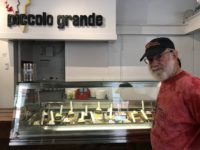

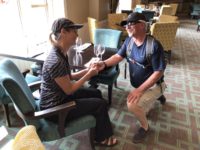 14 miles later, we docked just before the flight of 8 (yes, 8 locks long) in Ottawa in the middle of town. An awesome sight it was! From our boat, we could see Parliament, the Chateau Laurier (now a Fairmont Hotel, where Paul proposed to Cecelia several years earlier and reenacted for us), and many other beautiful limestone buildings!
14 miles later, we docked just before the flight of 8 (yes, 8 locks long) in Ottawa in the middle of town. An awesome sight it was! From our boat, we could see Parliament, the Chateau Laurier (now a Fairmont Hotel, where Paul proposed to Cecelia several years earlier and reenacted for us), and many other beautiful limestone buildings!

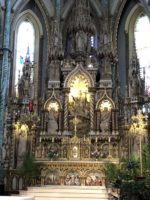 We walked to ByWard Market, past many vendors of flowers, foods, and tourist trinkets and bought cheese in one of the shops. Paul found Piccolo Grande with the best gelato ever. We looked out from an upper window in the National Gallery of Canada (art) over the city and walked inside Notre-dame Cathedral with its huge high ceiling painted blue with stars. It was beyond-description beautiful. (However, Paula was very disappointed to discover the gorgeous “marble” columns were actually wallpaper.) Outside, we saw about 5 bridal parties in town. You know – a beautiful city on a June weekend.
We walked to ByWard Market, past many vendors of flowers, foods, and tourist trinkets and bought cheese in one of the shops. Paul found Piccolo Grande with the best gelato ever. We looked out from an upper window in the National Gallery of Canada (art) over the city and walked inside Notre-dame Cathedral with its huge high ceiling painted blue with stars. It was beyond-description beautiful. (However, Paula was very disappointed to discover the gorgeous “marble” columns were actually wallpaper.) Outside, we saw about 5 bridal parties in town. You know – a beautiful city on a June weekend.
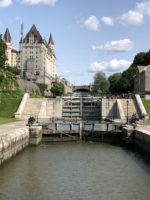 We walked to the bottom of Lock #1 (the bottom of the flight of 8), where the Rideau Canal and Ottawa River met. We were not going to do them, as we were going to return on the Rideau Canal back the way we came. Allowing 30 minutes per lock, that would have been 4 hours each way. Other than saying we did them, we really saw no reason to waste our time and fuel. And we didn’t need any more practice! We had figured out by the time we arrived at Ottawa, we had done 156 locks since the beginning of our first loop.
We walked to the bottom of Lock #1 (the bottom of the flight of 8), where the Rideau Canal and Ottawa River met. We were not going to do them, as we were going to return on the Rideau Canal back the way we came. Allowing 30 minutes per lock, that would have been 4 hours each way. Other than saying we did them, we really saw no reason to waste our time and fuel. And we didn’t need any more practice! We had figured out by the time we arrived at Ottawa, we had done 156 locks since the beginning of our first loop.
 From there, we could see the province of Quebec across the river. There was a lovely path, and we watched a white shepherd playing in the water, trying to retrieve rocks his owner threw. We later also saw an English Cream Retriever, neither of which we had ever seen before. On our return to the boat, we walked through the ByTown Museum about the building of the Rideau Canal. We enjoyed a salmon dinner on the aft deck, also with Wally and Darcy from Summertime (with whom we were once again docked). What a magical place Ottawa was. It was a very walkable city and we had the best site of all from the Canadian Parks docks at the top of the “flight of 8.” After dark, we taught Paul and Cecelia Qwirkle. Tom wasn’t a very good host…he creamed us all!
From there, we could see the province of Quebec across the river. There was a lovely path, and we watched a white shepherd playing in the water, trying to retrieve rocks his owner threw. We later also saw an English Cream Retriever, neither of which we had ever seen before. On our return to the boat, we walked through the ByTown Museum about the building of the Rideau Canal. We enjoyed a salmon dinner on the aft deck, also with Wally and Darcy from Summertime (with whom we were once again docked). What a magical place Ottawa was. It was a very walkable city and we had the best site of all from the Canadian Parks docks at the top of the “flight of 8.” After dark, we taught Paul and Cecelia Qwirkle. Tom wasn’t a very good host…he creamed us all!
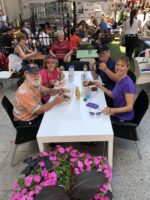 We found a great church on Sunday only a 5-minute walk from the boat. Grace City Church in a room at Shaw Center was so welcoming with a very good teacher. It was one of the most welcoming churches we have attended in all our cruising. Afterward, we “experienced” the Ottawa Ribfest, a 5-block gathering with 13 competitors. We tasted the sauce from every vendor before deciding on our choice. Tom, Paul, and Cecelia chose Camp 31 as their favorite, while Paula liked Crabby’s BBQ Shack. We later found out Camp 31 won 3 out of the 4 competitions (best ribs, best chicken, best sauce). The only one they missed was “people’s choice.” Go figure.
We found a great church on Sunday only a 5-minute walk from the boat. Grace City Church in a room at Shaw Center was so welcoming with a very good teacher. It was one of the most welcoming churches we have attended in all our cruising. Afterward, we “experienced” the Ottawa Ribfest, a 5-block gathering with 13 competitors. We tasted the sauce from every vendor before deciding on our choice. Tom, Paul, and Cecelia chose Camp 31 as their favorite, while Paula liked Crabby’s BBQ Shack. We later found out Camp 31 won 3 out of the 4 competitions (best ribs, best chicken, best sauce). The only one they missed was “people’s choice.” Go figure.
All too soon, Paul and Cecelia had to leave to go home. Cecelia had to work the next day, but Paul returned on Monday morning to chauffeur us around town for errand shopping. He was a blessing. All in all, we couldn’t have had more fun seeing Ottawa with Paul and Cecelia. From the minute they stepped on board, it was as if 5 months had not passed since we met. They had gone to a lot of work to prepare for our arrival and know what was going on in town that would be fun. We had a blast! Thank you, Paul and Cecelia.
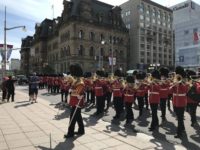 One other thing we enjoyed in Ottawa was the Changing of the Guard. About 9:45 each morning during the summer, there was a parade with the new guard to Parliament Hill where a 30-minute ceremony took place with much pomp as the guard was changed out. We stood beside a “guard groupie.” She lived in Ottawa and attended almost every day to support them. In addition, we did the House of Commons and Senate tours. Free tickets were obtained by advance reservations online. The locations were beautiful, even though they were both in temporary buildings due to Parliament Hall undergoing a 15-year renovation.
One other thing we enjoyed in Ottawa was the Changing of the Guard. About 9:45 each morning during the summer, there was a parade with the new guard to Parliament Hill where a 30-minute ceremony took place with much pomp as the guard was changed out. We stood beside a “guard groupie.” She lived in Ottawa and attended almost every day to support them. In addition, we did the House of Commons and Senate tours. Free tickets were obtained by advance reservations online. The locations were beautiful, even though they were both in temporary buildings due to Parliament Hall undergoing a 15-year renovation.
Tuesday (6/25), it was time to leave Ottawa. We had figured out itineraries to travel about 30 miles a day on our return to get to Trenton, Ontario in time for July 1, Canada Day, similar in activities to the US 4th of July. We weren’t sure we would like returning via the same route (we had never done an out-and-back before), but it turned out to be wonderful. We had made mental notes as we cruised to Ottawa of places we liked and wanted to check out on our return. We left in the rain and cold with a forecast of 0.4” of rain, but only had to do one lock before it stopped and we were back in our shorts by 11:00. It became windy in the “Long Reach” but we still enjoyed it immensely, as we had before.
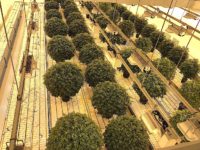 We stayed at Smith Falls alongside the park again because we had enjoyed it so much the first time. This time though, we walked about 2 miles to the free Tweed Visitor’s Center, the largest legal cannabis facility in the world. It existed in what used to be the Hershey’s Chocolate Factory. Founded in 2014 with 5 employees, its exponential growth increased it to 1,000 employees with facilities over 70 acres on the Smith Falls campus alone). We started with a film about how cannabis worked on the body and then walked through their facility with viewing windows above the growing facility. Of course, they tried to convince the public that recreational use should be legalized. The guide proudly told us they would soon be putting out chocolate again in the building. (He conveniently omitted what would be in that chocolate, but we bet you can guess.) No samples were available. In fact, you could not even buy any on-site because they did not have a sales permit for that location.
We stayed at Smith Falls alongside the park again because we had enjoyed it so much the first time. This time though, we walked about 2 miles to the free Tweed Visitor’s Center, the largest legal cannabis facility in the world. It existed in what used to be the Hershey’s Chocolate Factory. Founded in 2014 with 5 employees, its exponential growth increased it to 1,000 employees with facilities over 70 acres on the Smith Falls campus alone). We started with a film about how cannabis worked on the body and then walked through their facility with viewing windows above the growing facility. Of course, they tried to convince the public that recreational use should be legalized. The guide proudly told us they would soon be putting out chocolate again in the building. (He conveniently omitted what would be in that chocolate, but we bet you can guess.) No samples were available. In fact, you could not even buy any on-site because they did not have a sales permit for that location.
Paul and Cecelia joined us for one more evening’s meal, bringing us a package which had arrived at their house after we had left Ottawa (as well as more delicious goodies like cookies and jam Cecelia’s father had made). We ate maple smoked bacon pizza at Pizza Hut, a very Canadian and delicious treat.
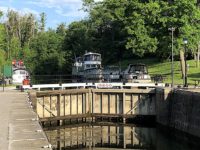 One additional stop we really enjoyed on our return was at the north side of Newboro Lock. It was the most popular overnight in the system, and fortunately, we arrived about 1:30 in the afternoon, as we heard it filled up fast. As we pulled up to the lock wall to dock, the lockmaster pointed out we had no bumper ball alongside! It seemed we had unknowingly lost a bumper in the Narrows Lock! Its lockmaster had called Newboro to tell us. It was sent down to us with the next boat. Newboro Lock was a very pretty spot, very quiet, with a pretty grass area. As often happened at locks, folks camped in the park next to the lock. We met some nice folks there, some of who boated nowhere else but the Rideau.
One additional stop we really enjoyed on our return was at the north side of Newboro Lock. It was the most popular overnight in the system, and fortunately, we arrived about 1:30 in the afternoon, as we heard it filled up fast. As we pulled up to the lock wall to dock, the lockmaster pointed out we had no bumper ball alongside! It seemed we had unknowingly lost a bumper in the Narrows Lock! Its lockmaster had called Newboro to tell us. It was sent down to us with the next boat. Newboro Lock was a very pretty spot, very quiet, with a pretty grass area. As often happened at locks, folks camped in the park next to the lock. We met some nice folks there, some of who boated nowhere else but the Rideau.
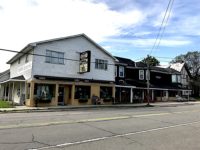 We got the scooter down and rode to Westport about 8 miles away and enjoyed the small town with nice shops. The next morning, we walked 8 minutes to the main street of Newboro to Kilborn’s. We were constantly amazed at the large stores that existed in small towns. This one had everything a woman could want, from clothes, to shoes, to kitchen supplies, and home décor. Paula asked the head clerk of shoes if she knew how many shoes they had in the store. She started counting…36 brands of shoes, about 40 styles each (that would make 1,440 shoes) with about 12 pairs in each style to cover sizes (that would come to 17,280 shoes). Incredible! If money were no object, Paula would have walked out with about 20 pair!
We got the scooter down and rode to Westport about 8 miles away and enjoyed the small town with nice shops. The next morning, we walked 8 minutes to the main street of Newboro to Kilborn’s. We were constantly amazed at the large stores that existed in small towns. This one had everything a woman could want, from clothes, to shoes, to kitchen supplies, and home décor. Paula asked the head clerk of shoes if she knew how many shoes they had in the store. She started counting…36 brands of shoes, about 40 styles each (that would make 1,440 shoes) with about 12 pairs in each style to cover sizes (that would come to 17,280 shoes). Incredible! If money were no object, Paula would have walked out with about 20 pair!
 The next day, we had to wait about 40 minutes at Jones Falls Lock, a lock where we had overnighted previously. But this time, the blacksmith shop and defensible lockmaster house were open and we got to watch the blacksmith make a nail for us. Here are some blacksmithing phrases of which you probably didn’t know the origin:
The next day, we had to wait about 40 minutes at Jones Falls Lock, a lock where we had overnighted previously. But this time, the blacksmith shop and defensible lockmaster house were open and we got to watch the blacksmith make a nail for us. Here are some blacksmithing phrases of which you probably didn’t know the origin:
- Smash it to smithereens – smithereens are the metal shavings that splinter off when a metal piece is worked
- Strike while the iron is hot
- Too many irons in the fire
- Go at it hammer and tongs
- It has a nice ring to it
- Don’t lose your temper
- Beat the daylights out of it
 During the Rideau Canal trip, we saw a marmot, 2 minks (one baby, whose picture you would see…if only there had been a card in Tom’s camera), an otter, a red fox, many chipmunks, black squirrels, turtles, a garter snake, many loons (with babies), beautiful swans and a few black snakes. It was a wildlife treasure trove.
During the Rideau Canal trip, we saw a marmot, 2 minks (one baby, whose picture you would see…if only there had been a card in Tom’s camera), an otter, a red fox, many chipmunks, black squirrels, turtles, a garter snake, many loons (with babies), beautiful swans and a few black snakes. It was a wildlife treasure trove.
We turned west after passing Kingston again along the northern coastline of Lake Ontario. Trent-Severn…here we come!
Here are a few more pictures from our travels.

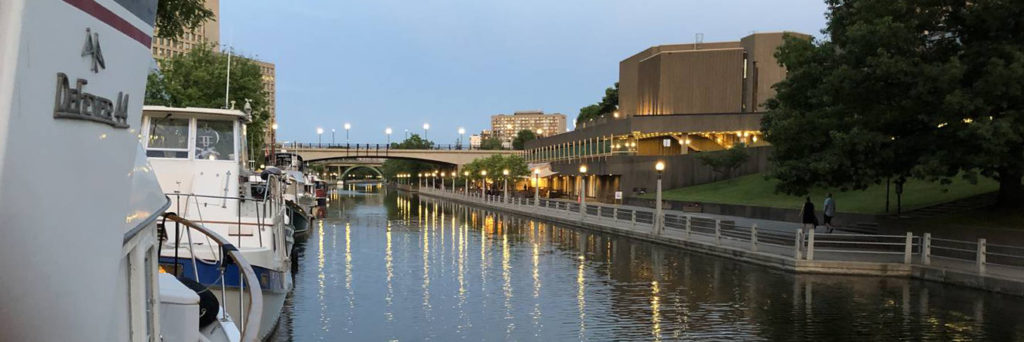
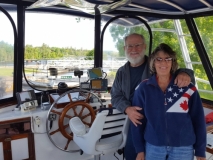

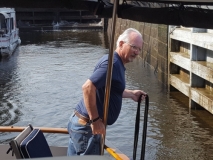
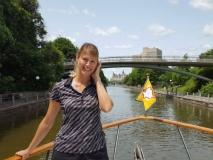
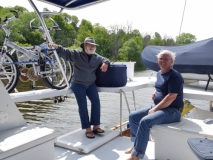
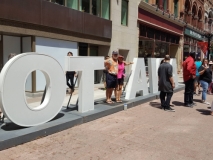
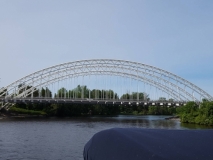


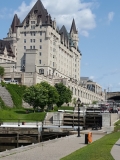
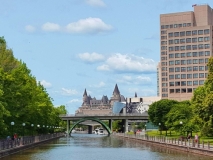

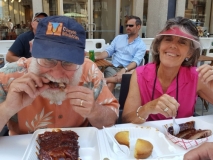
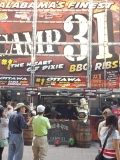
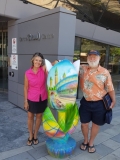
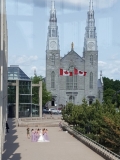
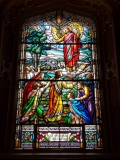
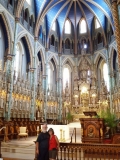
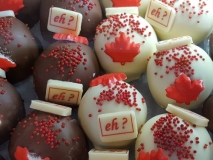
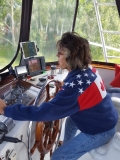
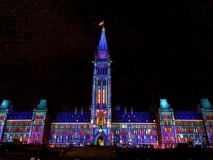
This was a great blog, Paula and Tom…I’m so glad you enjoyed your time on the Rideau Canal, and your visit to Ottawa. We certainly appreciated the chance to see you both again. Safe travels going south.